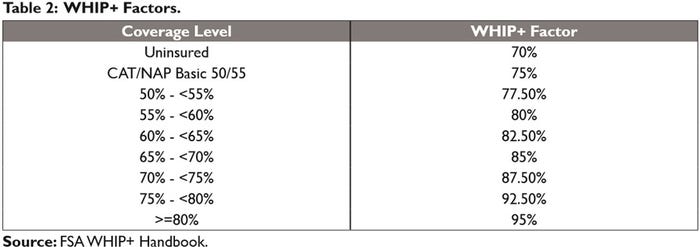
During the 2018 and 2019 crop years, 707 U.S. counties faced extreme (D3) drought levels or worse, according to the Texas A&M Agriculture and Food Policy Center (AFPC). In response, Congress expanded USDA's Wildfire Hurricane Indemnity Program Plus (WHIP+) to include drought loss, which is good news for Southwest growers.
The Wildfires Hurricanes Indemnity Program (WHIP) is a USDA disaster payment program created in 2017 to offset losses from wildfires and hurricanes. In June of 2019, Congress passed the Additional Supplemental Appropriations for Disaster Relief Act of 2019, which led to the creation of WHIP+.
"Additional money from the original WHIP program was leftover, so the WHIP+ program was expanded to cover additional disaster events in 2018 and 2019 (including drought, excess moisture and quality losses due to a qualifying disaster), which impacts a large part of the Southwest," says National Cotton Council's Vice President of Economics and Policy Analysis Jody Campiche.
"In 2018 and 2019, we have a lot of Oklahoma, Texas, and Kansas counties that will qualify for WHIP+ coverage," Campiche says. "USDA hasn't released all of the implementation details yet, but they will be coming out soon."
To qualify, growers must farm in a county rated D3 (extreme drought) or higher by the U.S. Drought Monitor for the 2018 and/or 2019 crop years (Fig. 1), says Bart Fischer, AFPC co-director & research assistant professor, Department of Agricultural Economics, Texas A&M University. "We're still waiting on USDA to put out all of the rules. Until then, everything's preliminary."

Below is the WHIP+ development timeline, according to the AFPC publication, "Overview of Drought Relief Provisions in the FY2020":
Since the 2008 farm bill: Very little supplemental disaster assistance for agriculture has been appropriated.
February of 2018: Bipartisan Budget Act of 2018 is created in response to hurricanes Harvey, Irma, and Maria and others, along with wildfires during the 2017 calendar year. Congress appropriates $2.36 billion for disaster assistance, which U.S. Secretary of Agriculture Sonny Perdue used to establish WHIP.
June of 2019: Following hurricanes Michael and Florence and other natural disasters occurring in 2018 and 2019, Congress passes the Additional Supplemental Appropriations for Disaster Relief Act of 2019. The act includes $3 billion for necessary expenses related to crop losses, including milk, on-farm stored commodities, crops prevented from planting in 2019, and harvested adulterated wine grapes, trees, bushes, and vines. USDA changes the name of the program to WHIP+.
December of 2019: Congress passes the FY2020 Further Consolidated Appropriations Act and made losses due to drought, excessive soil moisture, and quality loss during crop years 2018 and 2019 eligible for WHIP+.
WHIP+
A few things to know about WHIP+, according to the AFPC document, include:
WHIP+ value: the value is based on a person's crop insurance coverage — the higher the crop insurance coverage, the higher your WHIP+ factor (See Table 2)
Payment limit: $125,000 per person or legal entity cumulative for years 2018, 2019, and 2020.
Optional payment limitation: if at least 75% of a person’s or legal entity’s AGI is from farming, ranching or forestry, a payment limitation of $250,000 per person or legal entity applies to each of the program years 2018, 2019, and 2020, and can't exceed $500,000 in total.

"This infusion of working capital comes at a precarious time for many producers and their creditors who have suffered from a six-year slump in the farm economy," says Fischer. "For those producers impacted by extreme drought or worse, this will be welcome news."
Campiche and Fischer were guest speakers at the 2020 Red River Crops Conference in Altus, Okla., in mid-January. To view the AFPC document, log onto http://bit.ly/2txne9F.
About the Author(s)
You May Also Like






